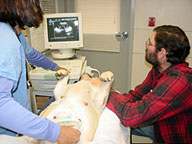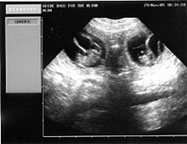|
The following information gathered from http://www.schaferhund.com This calendar is from her L litter in 2006. |
|
|
Wed 2 Nov 2005 First day of mating. |
|
|
|
48 hours after the first mating the bitch should be mated again. Subsequent matings occurring over a period of time enhance the chances of fertilization taking place. The spermatozoa migrate up through the cervix. |
|
Thu 3 Nov 2005 |
|
|
|
Sperm travel searching for a mature ripened eggs. |
|
Fri 4 Nov 2005 |
|
|
|
Spermatozoa reach the eggs in the oviducts. |
|
Sat 5 Nov 2005 |
|
|
|
Fertilization occurs in the oviducts which lead from the ovaries to the uterus. |
|
Mon 7 Nov 2005 |
|
|
|
Fertilized eggs migrate down the oviducts and into the uterine horns. The migration continue to enable even spacing of the embryos. During this migration the eggs will grow into a blastocystes. |
|
Tue 15 Nov 2005 |
|
|
|
The blastocystes implant in the wall of the uterus. |
|
Wed 16 Nov 2005 – Wed 23 Nov 2005 |
|
|
|
Dams nipples begin to pink and enlarge. The fur on the dams belly and around the nipples may become thinner. |
|
Sun 13 Nov 2005 – Sun 27 Nov 2005 |
|
|
|
The blastocystes will grow into an embryos. |
|
Tue 22 Nov 2005 – Tue 29 Nov 2005 |
|
|
|
Morning sickness might occur due to hormonal changes or stretching and distension of the uterus. Dam may appear a bit apathetic. She may be off her feed for a while and vomit from time to time. Feeding the dam several meals spaced throughout the day might help. Your veterinarian may want to prescribe a drug to relax the uterus. Alda is now very mellow and sleepy. Her response to seeing the Vet for the ultrasound was quiet and unexcited (not her usual self). She is eating well and seems hungry. |
|
Sun 27 Nov 2005 – Thu 1 Dec 2005 |
|
|
|
An experienced person (a breeder or a veterinarian) can tell by careful palpation whether the dam is pregnant. It’s now the best time to do this because the embryos are walnut-sized now and easy to count. |
|
Tue 29 Nov 2005 |
|
|
|
Ultrasound appointment at GDB. Alda has between 6 and 7 pups. This is just a guess things can always change. |
|
|
|
|
Wed 30 Nov 2005 |
|
|
|
Start to increase the dams food ration. Don’t overfeed, excessive weight gain should be avoided. The fetuses are now and are fully developed miniature dogs. Alda’s daily food increases from 3 cups to 4 cups. |
|
Tue 6 Dec 2005 |
|
|
|
The Dams abdomen starts to get larger. Alda’s daily food increases to 5 cups. |
|
Wed 14 Dec 2005 |
|
|
|
Alda’s daily food increases to 6 cups. |
|
Fri 16 Dec 2005 |
|
|
|
It’s very easy now to feel the puppies, counting them might be a bit more difficult. |
|
Mon 19 Dec 2005 – Tue 27 Dec 2005 |
|
|
|
Dam begins to spend a lot more time in self-grooming. Her breasts become even more swollen. She may become a bit restlessness and begin to search for a suitable place to have her puppies. |
|
Wed 21 Dec 2005 |
|
|
|
The dam might lose her appetite during this period. Her abdomen can be crowded with puppies. It is better to feed several smaller meals spaced throughout the day. You can easily detect abdominal movement now. |
|
Wed 22 Dec 2005 – Thu 5 Jan 2006 |
|
|
|
Nipples and vulva should be gently cleaned with warm water, you might want to trim the hairs surrounding the nipples, to allow easier access for the puppies to suck. |
|
Tue 27 Dec 2005 |
|
|
|
Alda’s “return to GDB” date. |
|
Sat 31 Dec 2005 – Tue 3 Jan 2006 |
|
|
|
Milky fluid may be expressed from the nipples. |
|
Sun 1 Jan 2006 |
|
|
|
Alda’s due date. You might want to start taking the dams rectal temperature each morning and evening. |
|
Wed 4 Jan 2006 |
|
|
|
Twelve to 24 hours before she is due to deliver, the dams rectal temperature may drop from 101 to 98 degrees. Clear discharge from the vulva might occur. |
|
Thu 5 Jan 2006 |
|
|
|
Expected date of whelp. Of course this is just an average. Whelping may take place from the 59th to the 65th day. Puppies born before the 58th day will probably be too young to survive. |
Archive for December, 2007
Dog Pregnancy Calendar
Tuesday, December 4th, 2007Guide Dogs for the Blind – Training Phases
Tuesday, December 4th, 2007Phase #1
- Pre-training physical exam
- Neutering/spaying (with the exception of potential breeding stock dogs who are under evaluation at this time)
- X-rays
- Eye checks
- Relaxing walks on campus and play sessions
- Introduction to the kennel environment and schedule
- General daily care and grooming
Phase #2
- Preliminary obedience training
- Exposure to distractions (toys, food, other dogs, cats, etc.)
- First on-campus workouts with a harness
- Introduction to the BEST program training techniques (including treadmill sessions)
- Sessions to teach guidework-specific commands (such as “Forward,” “Halt,” “Hop Up” and “Steady”) and the desired responses to the commands
- On leash introduction to the campus obstacle course
Phase #3
- Guidework training in quiet residential areas
- Frequent rides in the training vans
- Introduction to more advanced guidework commands and responses (“Right,” “Left,” and “Over Here,”); continued training on commands learned in Phase #2
- Introduction of curbs and street crossings
- Progressive obstacle course training on campus
- Continued obedience training
- Mall exposure walks
- Dog social sessions
- Neutering/spaying for those dogs dropped from the breeder-watch list
Phase #4
- Progression of guidework training: more difficult sidewalks in busier sections of downtown areas
- Training on more complex street crossings and curbs
- Obstacle clearance initiated by the dogs; they begin to guide their mobility instructors through the campus obstacle course
- Preliminary obedience testing and evaluation of the dogs’ reactions to head collars
Phase #5
- Preliminary guidework testing with the mobility instructor under blindfold
- Complete veterinary history review
- More challenging guidework training environments (pedestrian traffic, stairs, different flooring surfaces, etc.)
Phase #6
- Guidework routes in difficult and challenging work environments (heavy pedestrian and vehicle traffic areas, wide crossings, hectic atmospheres, etc.)
- Introduction to sidewalkless areas and rounded curbs
- Continued work in malls, stores and buildings, with increasing exposure to varying sights, sounds and smells
- Lessons in advanced guidework skills, such as moving turns
- Introduction to “intelligent disobedience” (dogs learn to refuse to obey a command if it is unsafe to execute)
- Advanced obedience training
Phase #7
- Guidework in extremely challenging downtown urban areas (San Francisco and Portland)
- Training on buses, light rail/subway systems and platform edges
- Introduction to low overhead clearances
- Advanced off-leash obedience
- Formal traffic training
Phase #8
- Advanced guidework and obedience training continues
- Intensive indoor mall training with crowds and slick floors
- Escalator training
- Advanced sidewalkless training with obstacles.
Phase #9
- Final obedience testing, including on-leash obedience with the mobility instructor wearing a blindfold
- Off-leash obedience with distractions
- Workouts with unfamiliar or novice handlers
- Final traffic testing with instructor under blindfold and “real life” traffic situations
Phase #10
- Final guidework testing: city streets. Includes working a 40-50 minute route with the mobility instructor wearing a blindfold in downtown Gresham or San Rafael. The route covers nearly every aspect of guidework (curbs, street crossings, stairs, buildings, crowded sidewalks, traffic, etc.); obedience exercises are done along the way.
- Final guidework testing: inside buildings (malls, stores, etc.). Includes working escalators, elevators, stairs, etc. with the mobility instructor wearing a blindfold.
- Final physical exams
(From Guide Dogs for the Blind)
Coat Color Inheritance Chart
Sunday, December 2nd, 2007The following information is from: http://www.vetgen.com/schippcolor.html
For example, if your dog is a Type V, (yellow dog with a black nose carrying the hidden genes for black). If you were to mate your dog with a Type III, the resulting litter would, on the average, all the puppies would be black. These probabilities represent expectations averaged over the long run and are subject to the law of probabilities.
| I | II | III | IV | V | VI | VII | VIII | IX | |
| I | All Black |
All Black |
All Black |
All Black |
All Black |
All Black |
All Black |
All Black |
All Black |
| II | All Black |
¾ Black ¼ Yellow |
All Black |
¾ Black ¼ Yellow |
½ Black ½ Yellow |
½ Black ½ Yellow |
½ Black ½ Yellow |
All Black |
¾ Black ¼ Yellow |
| III | All Black |
All Black |
¾ Black ¼ Choc. |
¾ Black ¼ Choc. |
All Black |
¾ Black ¼ Choc. |
½ Black ½ Choc. |
½ Black ½ Choc. |
½ Black ½ Choc. |
| IV | All Black |
¾ Black ¼ Yellow |
¾ Black ¼ Choc. |
9/16 Black ¼ Yellow 3/16 Choc. |
½ Black ½ Yellow |
3/8 Black ½ Yellow 1/8 Choc. |
¼ Black ½ Yellow ¼ Choc. |
½ Black ½ Choc. |
3/8 Black ¼ Yellow 3/8 Choc. |
| V | All Black |
½ Black ½ Yellow |
All Black |
½ Black ½ Yellow |
All Yellow |
All Yellow |
All Yellow |
All Black |
½ Black ½ Yellow |
| VI | All Black |
½ Black ½ Yellow |
¾ Black ¼ Choc. |
3/8 Black ½ Yellow 1/8 Choc. |
All Yellow |
All Yellow |
All Yellow |
½ Black ½ Choc. |
¼ Black ½ Yellow ¼ Choc. |
| VII | All Black |
½ Black ½ Yellow |
½ Black ½ Choc. |
¼ Black ½ Yellow ¼ Choc. |
All Yellow |
All Yellow |
All Yellow |
All Choc. |
½ Choc ½ Yellow |
| VIII | All Black |
All Black |
½ Black ½ Choc. |
½ Black ½ Choc. |
All Black |
½ Black ½ Choc. |
All Choc. |
All Choc. |
All Choc. |
| IX | All Black |
¾ Black ¼ Yellow |
½ Black ½ Choc. |
3/8 Black ¼ Yellow 3/8 Choc. |
½ Black ½ Yellow |
¼ Black ½ Yellow ¼ Choc. |
½ Yellow ½ Choc. |
All Choc. |
¾ Choc ¼ Yellow |

